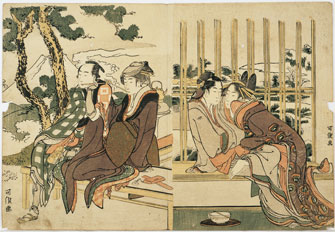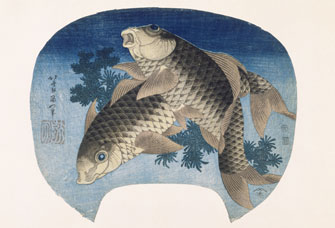A New Way of
Looking at the World

“Chōshi in the Province of Sōshū” from the series “One Thousand Pictures of the Sea” (c. 1830-34). © Rmn-Grand Palais (Musée Guimet, Paris)/Thierry Olivier
Japanese illustration and printmaking have been the subject of a number of exhibitions recently, the latest and biggest being “Hokusai” at the Grand Palais in Paris. To my mind, this is the least satisfactory of them all. Every one of the pictures produced by Hokusai deserves to be admired in detail, but this show makes it difficult. It suffers from an overambitious range, too many visitors, uncomfortably dim lighting (unfortunately necessary to protect these fragile artworks) and lack of adequate explanation of this complex art.
After a long, chilly wait outside, you can expect to be frustrated as you wait your turn to slowly move along the display cases and peer at the tiny, exquisite details in the pictures. A cursory 10-second look is hardly enough, but those waiting behind you are likely to intimate that it’s time to move on, sometimes by elbowing you out of the way.
A vast array of the master’s output is represented, from drawings and preliminary studies to final printed works, whether in the form of graphic storybooks (the ancestors of comic books and animation) or multicolored prints.
Hokusai (Katsushika Hokusai, 1760-1849) was just one of many Japanese artists working in the heyday of this Japanese graphic tradition during the Edo period at the end of the 18th and beginning of the 19th century, a period with an extraordinarily rich culture, notably onstage, with kabuki theater providing a form for the telling of heroic deeds and legends. Kabuki actors use magnificent costumes, elaborate scenic effects and a highly stylized code of expressions and movements that lend themselves to being commemorated in graphic form.
The flourishing of this art coincided with an urban lifestyle, all about pleasure and sophisticated enjoyment, called ukiyo (“floating world”). Images related to this world are known as ukiyo-e and mostly consist of woodcuts. Four types of art professionals were involved in this industry: an editor to source the money and receive a commission for a work; an artist to draw the image on fine paper; an engraver to transfer the drawing to a specially prepared wooden block; and a printer to handprint the image onto paper, sometimes over-printing in several colors.
At the height of the movement, Japanese artists produced pictures on a wide variety of subjects: actors, beautiful women, famous samurai warriors, and scenes of Japanese nature and life, including birds, plants, rivers and mountains. They also made graphic booklets (manga) on a variety of subjects.
The sudden opening of Japan’s frontiers to the West in the middle of the 19th century led to a worldwide craze for this imagery. Many European artists were influenced by these striking graphic forms, which were so different from Western art. Unfortunately, the high level of demand from foreign collectors led to a rapid decline in the quality of this magnificent and distinctive culture.
The first room of the Grand Palais exhibition looks at the Japanese influence on Western art during this period. A collection of French Creil-Montereau and Jules Vieillard china from the 1870s illustrates the fashion for oriental designs in upper-class European society in the fin de siècle period, when Japanese designs were popularized through a number of influential books published in Paris by Félix Bracquemond, Emile Gallé and Edmond de Goncourt.
After learning the block-making craft as an apprentice, Hokusai soon devoted himself to drawing and in 1794 changed his name to Sōri, celebrating a confident new style, which lasted up to 1805. Some of the works, including surimono brush paintings, show astonishing modernity in their photo-like cropping and subject matter.
In “Seven Manners of Young Women without Elegance,” we see close-up portraits of the subjects with elaborate hairstyles held together with chopsticks. What exactly was inelegant about these young women? We do not know – perhaps the piled-up hair or eye makeup was

“Lingering Snow for Azuma and Yohei” and “Evening Glow for Date no Yosaku and Seki no Koman” (1760 -1849).
considered tarty by the discerning young men of Edo (Tokyo).
During the next phase of his life, Hokusai abandoned portraits of courtesans and actors, turning to scenes of life and natural scenery around Japan and inventing

“Two Carps” (1831). © Rmn-Grand Palais (Musée Guimet, Paris)/Thierry Ollivier
a new graphic language in the process. He produced many series of views and stylized representations of sites around his homeland, among them the delightful, delicately tinted “Sailboats Returning at Shinagawa,” “Setting Sun at Seta” and “Morning Mist at Awazu.” Numerous silk kakemono (scroll paintings) reflect the artist’s passion for nature and detailed observation of the organic forms of plant life.
It is when you want to examine some of the many humorous and charming scenes such as “Chinese Children Arguing during a Game of Go,” that you yearn for a quieter, better lit environment in which to enjoy the artist’s amusing touches.
Around 1815 the first of a series of art manuals featuring drawings, the Hokusai Manga, started to appear. Books of the 15-volume series were intended as a reference for young artists and included a huge range of subject matter, including animals, humans in all sorts of positions, buildings, transport vehicles and subjects from nature. Western artists and designers have raided these manuals unashamedly for ideas ever since. Thanks to his eye for detail, his amazing dexterity and creative genius, Hokusai invented a new way of looking at the world.
The introduction of new color inks, including Prussian blue, in Japan in the 1830s made possible the breathtakingly beautiful effects in Hokusai’s best-known images, such as “Thirty-six Views of Mount Fuji,” produced toward the end of his long career. With “In the Lee of a Wave” or the iconic “The Great Wave Off Kanagawa” the artist gained worldwide recognition.
A few years before he died in 1849, Hokusai told his pupils: “It was not until my 70th year that I produced anything of significance.”
It is a pity that the Grand Palais curators paid such scant attention to explaining the impressive skill required for making ukiyo-e. The video shown near the end of the exhibition should have been placed at the beginning to give visitors a better idea of the amazing craftsmanship and dexterity involved. A live demonstration by a master craftsman at work would have been ever better.
If the Hokusai exhibition whets your appetite for Japanese art, you may want to pay a visit to a highly enjoyable exhibition of a another popular genre, shunga (erotic art), “Au Temps des Geishas,” at the Pinacothèque in Paris. The best artists, including Hokusai, would be discreetly asked to make shunga for wealthy clients, many of them Westerners. When I attended the Pinacothèque show, there was hardly anyone there, an environment much more conducive to unhurried observation.
Shunga focused not only on sexual contortions and certain exaggerated bodily details (discretion prevents me from expanding further), but also on the fine quality of the silk robes or kimonos worn by the participants. Some see this obsession with textiles as a “fetish,” and there is something sensual about the way the folds of material are drawn around the bodies. If I were a purveyor of sexy lingerie, I would definitely include those all-embracing kimonos in my catalogue.
If you happen to be in Geneva, the exhibition of Japanese art devoted to Kabuki theater of the same period, “Le Geste Suspendu,” at the Musée d’Art et d’Histoire’s Cabinet d’Arts Graphiques, is well worth a visit. An entertaining, brightly coloured array, produced from the Swiss city’s own collection, is on show. Here you can see portraits of famous actors, posters used to attract the audience and designs intended for use on lamps and fans.
Galeries Nationales du Grand Palais: 3, avenue du Général Eisenhower, 75008 Paris. Métro: Champs-Elysées Clemenceau. Tel.: 01 44 13 17 17. Open Wednesday-Saturday, 10am-10pm (until midnight on October 4); Sunday-Monday, 10am-8pm. Closed Tuesday and December 25. Admission: €13. Through January 18, 2015. www.grandpalais.fr
Pinacothèque de Paris: 28, place de la Madeleine, 75008 Paris. Métro: Madeleine. Tel.: 01 42 68 02 01. Open Wednesday-Monday, 10:30am-18:30pm, until 8:30pm on Wednesday and Friday. Closed Tuesday. Admission: €13. Through February 15. www.pinacotheque.com
Musée d’Art et d’Histoire: Cabinet d’Arts Graphiques, Promenade du Pin 5, 1204 Geneva. Tel.: +41 (0)22 418 26 00. Open Tuesday-Sunday, 11am-6pm. Closed Monday. Admission CHF Through January 11. www.mah-geneve.ch
Click here to read all of this week’s new articles on the Paris Update home page.
Reader Derek Brampton writes:“I couldn’t agree more with your article. I traveled from the UK especially to see this exhibition on the grounds of ‘last chance’ and ‘will not be allowed to travel again.’ I booked a timed ticket for 4.30 arriving at 4.15, only to be directed to a long queue. It was raining, it was getting dark and very cold. Rain had collected in the gravel, and the queue hardly moved. The attendants were as fed up as we were. The steps were slippery and nobody had thought to sweep them. I cannot remember ever waiting in such unpleasant conditions. Surely in the winter, the Grand Palais occupies enough space to let people wait inside. When I entered the building, it was almost 5. What is the point of a timed ticket?
“The galleries were seething with people, especially lots of schoolchildren. Viewing became a challenge. I understand the necessity for subdued lighting, but low display cases and bad explanations and signage made the situation worse.
“This is my memory of what I hoped to be a once-in-a-life time experience. Very disappointed.”
Reader Richard Ewan writes:“Thank you for your review of the excellent Hokusai show. I fought through the crowd, regressing back to my days of playing football as I jockeyed around people and stood firm and bounced off people’s shoulders to see the work up close. I agree that the printmaking video would have been much more effective at the beginning of the exhibit. By the time I got to it, my legs were shaking and even though I got my art degree in printmaking, I watched the entire video, fascinated by the tools used to cut and print the blocks. The most impressive aspect I saw was the rich and gentle gradation of colors in the prints.
“During my art history classes I had been informed about the influx of Japanese prints into France and the influence it had on the Impressionists. The so-called bird-eye view many impressionists painted came directly from the Japanese. Whenever I go to an exhibit in Paris I expect crowds and try to wish them away. I flit in and out of the clumps of observers and stand alone briefly to drink in the image before me. At least in Paris, the crowds are quieter than in the large exhibits in the US. It just beats not going at all!”
Reader Reaction: Click here to respond to this article (your response may be published on this page and is subject to editing).
Support Paris Update by ordering books from Paris Update’s Amazon store at no extra cost. Click on your preferred Amazon location: U.K., France, U.S.
© 2014 Paris Update
Favorite
